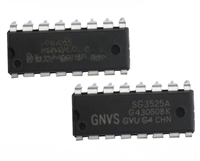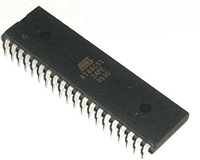AUDIO POWER AMPLIFIER DESIGN
Application Information (Continued)
Design a 1W/8Ω Audio Amplifier
external component combinations, consideration to compo-
nent values must be used to maximize overall system qual-
ity.
Given:
Power Output
Load Impedance
Input Level
1 Wrms
8Ω
The LM4871 is unity-gain stable which gives a designer
maximum system flexibility. The LM4871 should be used in
low gain configurations to minimize THD+N values, and
maximize the signal to noise ratio. Low gain configurations
require large input signals to obtain a given output power. In-
put signals equal to or greater than 1 Vrms are available
from sources such as audio codecs. Please refer to the sec-
tion, Audio Power Amplifier Design, for a more complete
explanation of proper gain selection.
1 Vrms
20 kΩ
Input Impedance
±
100 Hz–20 kHz 0.25 dB
Bandwidth
A designer must first determine the minimum supply rail to
obtain the specified output power. By extrapolating from the
Output Power vs Supply Voltage graphs in the Typical Per-
formance Characteristics section, the supply rail can be
easily found. A second way to determine the minimum sup-
ply rail is to calculate the required Vopeak using Equation 3
and add the output voltage. Using this method, the minimum
Besides gain, one of the major considerations is the closed-
loop bandwidth of the amplifier. To a large extent, the band-
width is dictated by the choice of external components
shown in Figure 1. The input coupling capacitor, Ci, forms a
first order high pass filter which limits low frequency re-
sponse. This value should be chosen based on needed fre-
quency response for a few distinct reasons.
supply voltage would be (Vopeak + (VOD
+ VODBOT)), where
VOD
and VOD
are extrapolated frToOmP the Dropout Volt-
TOP
age BvOsT Supply Voltage curve in the Typical Performance
Characteristics section.
Selection Of Input Capacitor Size
Large input capacitors are both expensive and space hungry
for portable designs. Clearly, a certain sized capacitor is
needed to couple in low frequencies without severe attenua-
tion. But in many cases the speakers used in portable sys-
tems, whether internal or external, have little ability to repro-
duce signals below 100 Hz to 150 Hz. Thus, using a large
input capacitor may not increase actual system perfor-
mance.
(3)
Using the Output Power vs Supply Voltage graph for an 8Ω
load, the minimum supply rail is 4.6V. But since 5V is a stan-
dard voltage in most applications, it is chosen for the supply
rail. Extra supply voltage creates headroom that allows the
LM4871 to reproduce peaks in excess of 1W without produc-
ing audible distortion. At this time, the designer must make
sure that the power supply choice along with the output im-
pedance does not violate the conditions explained in the
Power Dissipation section.
In addition to system cost and size, click and pop perfor-
mance is effected by the size of the input coupling capacitor,
Ci. A larger input coupling capacitor requires more charge to
reach its quiescent DC voltage (nominally 1/2 VDD). This
charge comes from the output via the feedback and is apt to
create pops upon device enable. Thus, by minimizing the ca-
pacitor size based on necessary low frequency response,
turn-on pops can be minimized.
Once the power dissipation equations have been addressed,
the required differential gain can be determined from Equa-
tion 4.
(4)
Besides minimizing the input capacitor size, careful consid-
eration should be paid to the bypass capacitor value. Bypass
capacitor, CB, is the most critical component to minimize
turn-on pops since it determines how fast the LM4871 turns
on. The slower the LM4871’s outputs ramp to their quiescent
DC voltage (nominally 1/2 VDD), the smaller the turn-on pop.
Choosing CB equal to 1.0 µF along with a small value of Ci
(in the range of 0.1 µF to 0.39 µF), should produce a virtually
clickless and popless shutdown function. While the device
will function properly, (no oscillations or motorboating), with
=
Rf/Ri AVD/2
(5)
From Equation 4, the minimum AVD is 2.83; use AVD = 3.
Since the desired input impedance was 20 kΩ, and with a
AVD impedance of 2, a ratio of 1.5:1 of Rf to Ri results in an
allocation of Ri = 20 kΩ and Rf = 30 kΩ. The final design step
is to address the bandwidth requirements which must be
stated as a pair of −3 dB frequency points. Five times away
from a −3 dB point is 0.17 dB down from passband response
±
which is better than the required 0.25 dB specified.
fL = 100 Hz/5 = 20 Hz
CB equal to 0.1 µF, the device will be much more susceptible
to turn-on clicks and pops. Thus, a value of CB equal to
1.0 µF is recommended in all but the most cost sensitive de-
signs.
fH = 20 kHz * 5 = 100 kHz
As stated in the External Components section, Ri in con-
junction with Ci create a highpass filter.
Ci ≥ 1/(2π*20 kΩ*20 Hz) = 0.397 µF; use 0.39 µF
The high frequency pole is determined by the product of the
desired frequency pole, fH, and the differential gain, AVD
.
With a AVD = 3 and fH = 100 kHz, the resulting GBWP =
150 kHz which is much smaller than the LM4871 GBWP of
4 MHz. This figure displays that if a designer has a need to
design an amplifier with a higher differential gain, the
LM4871 can still be used without running into bandwidth limi-
tations.
www.national.com
6






 SG3525资料手册详解:SG3525参数分析、引脚说明、应用介绍
SG3525资料手册详解:SG3525参数分析、引脚说明、应用介绍

 AT89C51单片机资料手册详细解析及应用示例
AT89C51单片机资料手册详细解析及应用示例

 CP2102资料手册解读:CP2102引脚说明、关键参数分析
CP2102资料手册解读:CP2102引脚说明、关键参数分析

 资料手册解读:UC3842参数和管脚说明
资料手册解读:UC3842参数和管脚说明
